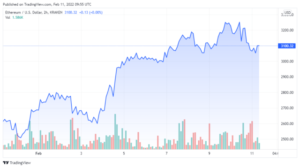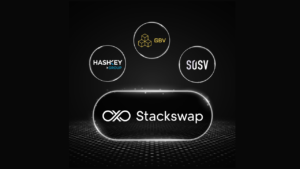
2021 was an eventful year for Moonbeam, the newest Polkadot-based smart contract platform that aims to provide users with a more scalable and cost-effective alternative to existing legacy chains.
Launched in January 2020 by Derek Yoo of Pure Stake, Moonbeam ranks among the most thriving “multichain” projects to join the Polkadot ecosystem. Designed to provide seamless integration and interoperability between Polkadot, Ethereum, Bitcoin, and other EVM-compatible chains, Moonbeam’s infrastructure operates as a parachain on the Polkadot network.
After securing a slot in the Kusama parachain, Moonbeam’s canary network Moonriver was launched as a parachain on the Kusama network in June 2021. Moonriver is currently live on Kusama following the scheduled five-phase launch, with over $241.53 million in total value locked (TVL).
Moonbeam offers a full EVM implementation, meaning that all Ethereum-compatible smart contracts and dApps can be easily deployed on Moonbeam without any changes to the underlying code. The platform supports Ethereum H160 accounts and ECDSA signatures, enabling developers to interact with its parachain with virtually no changes. Accordingly, developers can seamlessly migrate their existing Solidity APIs and contracts without the need for new addresses, accounts, and signatures.
While several platforms boast of Ethereum compatibility, they only offer partial features. With Moonbeam, developers gain exact Ethereum-like functionality, albeit with attributes like lower costs and greater scalability.
A Peek Into Moonbeam’s Performance
Moonbeam officially launched as a parachain on the Polkadot network on December 17th, 2021. As part of the first phase, the Moonbeam team has already begun decentralization and adding new third-party collators to its active collator set. Once the transition is complete, expected for later this month, Moonbeam’s network will go fully live on Polkadot.
Even though the Moonbeam network is yet to begin functioning at scale, its ease-of-use has already attracted dApp developers seeking a more rapid and cost-efficient alternative to Ethereum. In 2021, Moonbeam launched its public testnet, Moonbase Alpha, allowing developers to test its compatibility features.
As a Polkadot parachain experiencing rapid expansion, Moonbeam has been transformed into a diverse ecosystem of NFTs, DeFi, gaming, and other dApps within just a few months, positioning the parachain as the “Ethereum of Polkadot.” Since the platform supports popular NFT-based token standards like ERC-721 and ERC-1155, it has quickly become a leading destination for Ethereum-compatible NFTs.
By design, all projects that wish to deploy on Moonbeam must first be deployed on the Moonriver network. While the launch of Moonbeam is underway, the Moonriver ecosystem has established itself as the largest, most active, and most diverse parachains on Kusama, Polkadot’s canary network.
With full Ethereum compatibility and Polkadot’s built-in capabilities, Moonbeam is a true multichain platform that is developer-friendly and well equipped to accommodate a wide range of use cases. Moonbeam currently supports a diverse range of APIs and tools, bridges, collators, DeFi dApps, and other dApps related to oracles, storage, wallets, NFTs, explorers, gaming, and much more.
Moonriver has emerged as the ninth fastest-growing network in just five months of its launch on Kusama. Some of the leading projects that have already been deployed on Moonriver (and will soon be deployed on Moonbeam) include Ocean Protocol, Polkastarter, Poolz, AMPnet, Human Protocol, Livetree, BePro, Polkacover, and Authtrail, among others. The network is also witnessing a wave of NFT and gaming projects, such as Treasureland, myNFT, Moonbeans, Zoombies, Pinata, BankSea, and many more.
Other promising partnerships include C.R.E.A.M Finance, the decentralized lending protocol for individuals and institutions to bring lending and borrowing services, first on Kusama and then to Polkadot. The Moonbeam team has also joined forces with Magic, the plug-and-play authorization and key management solution, to introduce a new feature of scalable passwordless authentication for dApp developers.
Beyond these partnerships, Moonbeam has also expanded its list of integrations with oracles and APIs like TheGraph, SubQuery, Etherscan, Dapplooker, API3, OpenZeppelin, Biconomy, Chainlink, Razor, and Band Protocol, helping further end-to-end multichain capabilities for all dApps deployed on its network.
In addition to this, Moonbeam has partnered with Lido Finance to introduce liquidity staking on Polkadot and integrated with KYVE Network, the decentralized data archiving and caching solution, to ensure permanent data availability on both Moonbeam and Moonriver networks.
With the concept of interoperable and interconnected networks gaining momentum, Moonbeam has cemented itself as the easiest on-ramp to Polkadot, giving dApp developers the flexibility to port existing Solidity contracts and dApps with minimal codebase changes. At the same time, it also offers more than 60 built-in core developer integrations covering a wide range of tools and services while ensuring seamless interoperability with Ethereum and other parachains and parathreads within the Polkadot and Kusama networks.
Even though layer-2 scaling solutions have emerged as a promising solution to Ethereum’s problems, Moonbeam sets itself apart from the league. Unlike ZK and Optimistic Rollups, designed to help make Ethereum faster and more scalable, Moonbeam offers dual benefits of end-to-end Ethereum compatibility alongside Polkadot’s inherent features, powering and supporting a diverse range of use cases.
- 2020
- 2021
- active
- addition
- All
- Allowing
- Alpha
- already
- among
- APIs
- Authentication
- authorization
- availability
- band protocol
- benefits
- Bitcoin
- Borrowing
- capabilities
- cases
- Chainlink
- code
- contract
- contracts
- Costs
- dapp
- DApps
- data
- Decentralization
- decentralized
- decentralized lending
- DeFi
- Design
- Developer
- developers
- easily
- ecosystem
- enabling
- equipped
- established
- ethereum
- expansion
- expected
- faster
- Feature
- Features
- finance
- First
- Flexibility
- full
- functionality
- gaming
- Giving
- help
- HTTPS
- Infrastructure
- institutions
- integrated
- integration
- integrations
- Interoperability
- IT
- January
- join
- joined
- Key
- launch
- leading
- lending
- Liquidity
- List
- locked
- management
- Management Solution
- million
- Momentum
- months
- more
- most
- multichain
- network
- networks
- new feature
- NFT
- NFTs
- ocean
- offer
- Offers
- Other
- Others
- partnered
- partnerships
- permanent
- phase
- platform
- Platforms
- Polkadot
- Popular
- projects
- provide
- public
- range
- Scalability
- scalable
- Scale
- scaling
- seamless
- seeking
- Services
- set
- smart
- smart contract
- Smart Contracts
- solidity
- Solutions
- stake
- Staking
- standards
- storage
- Supports
- test
- third-party
- time
- token
- tools
- TVL
- users
- value
- Wallets
- Wave
- within
- without
- year












